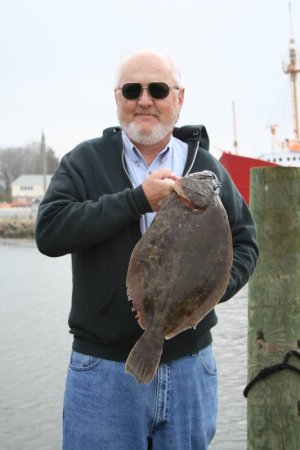There is no doubt that flounder is the top species for most bottom fishermen. Sure, we go after black sea bass, ling and porgies when we fish the deeper waters of the Old Grounds and the reef sites from Site 10 on out, but the guys or ladies who stick to their guns and target flounder usually end up winning the pool.
This year, the water inshore including the Back Bays and the Lewes-Rehoboth Canal has remained cool with some big flounder remaining therein. A 5.2-pound flounder out of Rehoboth Bay was caught by Jamy Yochis last week and checked in at Rick’s Bait and Tackle. That is about the shallowest body of water we have in the Cape area, and this is mid-June.
The same has been true for the Lewes-Rehoboth Canal. When Lewes Harbour Marina has had nothing to report from their charter fleet due to rough weather, they often have reports from small boats that have fished the canal with some success. Don’t get me wrong, no boat hits flounder limits, but usually around three or four nice fish for two folks fishing a tide.
The Old Grounds have seen some good flounder action as well. Here we have a lot of smaller fish, with some 17.5-inch keepers mixed in the catch. If you consider sites 10 and 11 in the same area as the Old Grounds, and I don’t, then the chances of hooking a keeper improve.
One way to cull out the shorts is to fish with live baits at the Old Grounds or at sites 10 or 11. Most folks use live spot with a circle hook on a fish-finder rig. How you acquire your spot is up to you. You can catch them in Indian River or Rehoboth bays by hook and line or by traps. Not clear on what kind, if any, license you need to trap spot. Back in the day, I bought them from Mrs. Murray at her bait and grocery store. Her husband Jim and daughter Shirley caught the product.
When fishing for flounder, you must keep in mind that these fish are ambush feeders. They lie in wait for a prey to pass by, then attack from below. Therefore, your presentation must look like a helpless spot, or whatever, and an easy meal to the flounder.
I have fished with a few great flounder fishermen. One thing they all had in common was if we made a drift and didn’t catch anything, we moved. We may come back to that spot later in the tide, but for now, we had proved there were no flounder there.
On the other hand, if we were catching flounder on a good drift, we stayed on the drift until the bite quit. When I say stayed on the drift, I mean right down the exact same depth along the exact same line until the bite stopped.
Fishing for flounder on hard structure is difficult. The fish will often lay tight to the structure around any scour holes made by openings in the bottom of the ship, subway car or whatever was used to create the reef. They are looking for bait that will be washed through these openings by the current, so it is difficult, if not impossible, to present your offering to these fish.
Fortunately, flounder also lay in channels and on top of the structure, so all is not lost. Using your sonar, look for openings between large pieces of whatever was used to build the reef and try to set a drift down that area. The subway cars have flounder on top of them, so drifting down there is another possibility.
Sometime lures can work better than bait. I have had good luck using two bucktails sweetened with Gulp! I use a 3- to 4-ounce bucktail on the bottom, and about 8 to 12 inches above that I tie on a teaser also adorned with a smaller version of Gulp! The teaser has about 5 to 6 inches of leader from the main line. A three-way swivel tied to the shock leader keeps all three lines happy.
While you can use spinning or conventional outfits, I prefer conventional. I feel I have better control of the bottom rig, and when I need 8 or 9 ounces to get down to the flounder, my conventional outfit can handle the job.
There should be no question that braided line is right for flounder fishing. It is more sensitive than monofilament and is also thinner so it has less resistance to the current. A top-shot of Fluorocarbon leader will protect the braid from the nasty stuff on the bottom.
It looks like the cool weather is over, so look for the flounder to move to deeper water.
























































